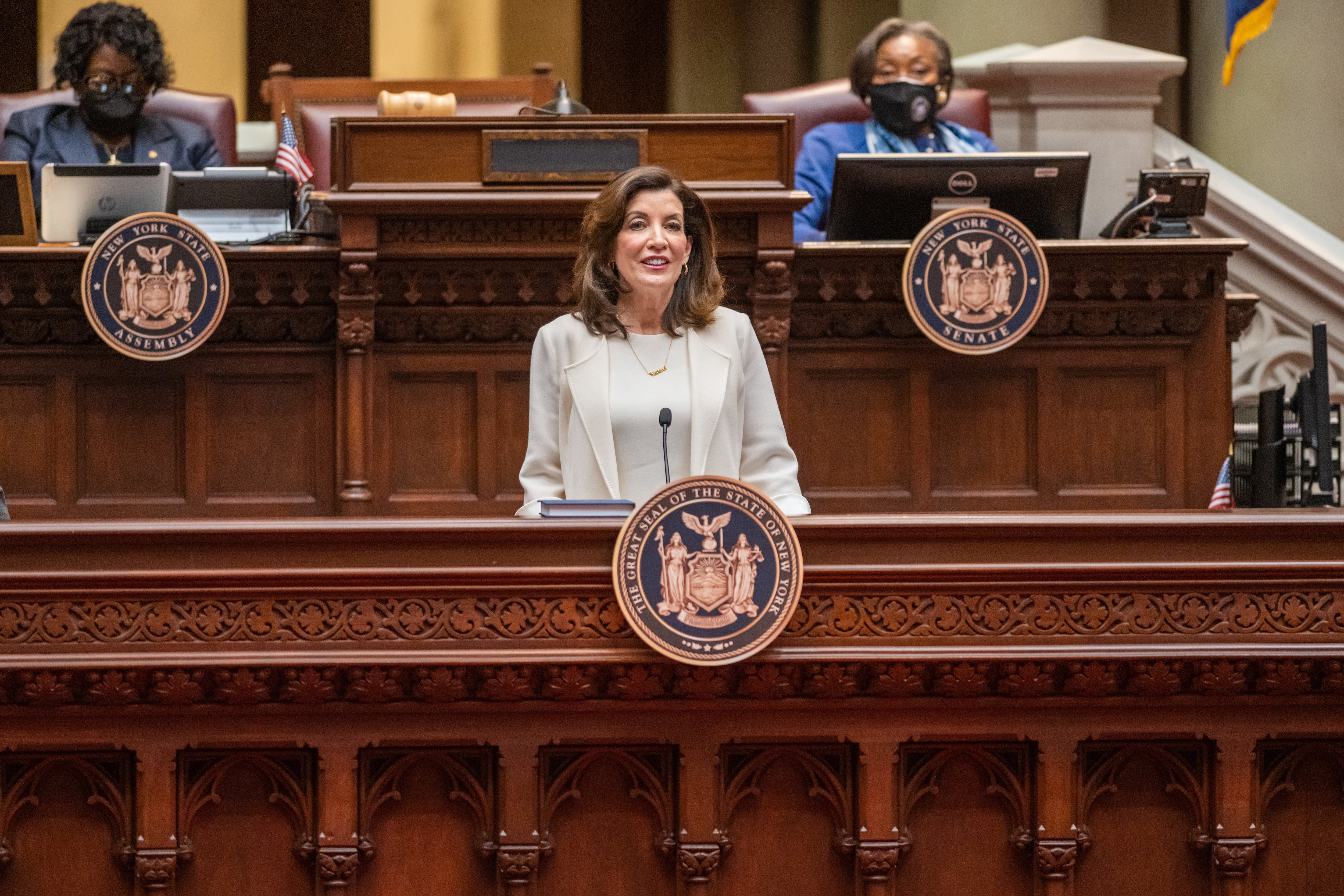In her first State of the State address, Gov. Kathy Hochul outlined plans to attract more teachers to New York, provide more mental health resources for schools, and ensure more New Yorkers earn a college degree.
Hochul’s speech marked the first time she offered a peek inside her priorities for the state’s public schools since taking office after former Gov. Andrew Cuomo resigned. She is running to keep the seat in this year’s November gubernatorial election.
From her first day in office in late August, Hochul’s administration has grappled with the coronavirus pandemic’s ongoing grip on schooling for the state’s 700-plus districts, including the nation’s largest in New York City. Most recently, she created a test-to-stay plan as a way to keep classrooms open through the recent COVID surge throughout the state and has strongly resisted closing school buildings.
However, her ideas for education outside of the public health crisis remained largely unknown until Wednesday, the start of the legislative session.
As she has previously promised, Hochul also proposed fully funding Foundation Aid, the state’s funding formula for schools that sends more money to higher-needs districts, by the 2023-2024 school year.
“I believe to my very core that there is nothing more valuable than education and training when it comes to unlocking opportunity and prosperity,” Hochul said. “It changes lives, across generations.”
Here are some of the governor’s proposals from her speech and a more in-depth policy book released Wednesday:
Teacher shortage
Education officials have long been concerned about a looming teacher shortage in New York. State education policymakers recently proposed getting rid of a controversial teacher certification test as one way to expand and diversify the state’s educator workforce.
Citing data from the state teachers union, Hochul’s proposal said enrollment in state teaching programs has decreased by more than half since 2009, and about a third of current teachers are projected to retire in the next five years. To address this, Hochul is proposing to speed up the teacher certification process and incentivize more people to become educators. She also wants to temporarily remove the cap on how much certain retired teachers can earn if they return to teaching, while earning pensions, but her plan did not elaborate on which teachers could be eligible.
One solution, Hochul believes, is to allow teachers, counselors, social workers, and other positions with shortages to immediately begin working without waiting through the education department’s approval process – so long as those prospective educators meet state requirements for completing coursework, fingerprinting and background checks. Honoring an ask from the state education department, Hochul also wants to add more staffers to the department’s certification office to speed up what she described as a “lengthy” approval process. It currently takes about 16 weeks, according to the department’s website.
To get more teachers into the pipeline, Hochul has proposed a new state teaching residency program. It would provide matching funding to local school districts so they can create two-year programs for graduate-level teacher candidates, who would be eligible for either reduced or free tuition at SUNY, CUNY, or partnering private colleges.
Hochul’s plan said the program would prioritize ”diversity among teacher candidates,” as well as high-need subject areas in locations with teacher shortages. But beyond that, she did not focus further on boosting teacher diversity, which in recent years has been a top concern of state education policymakers and advocates. The most recent data, from 2016-2017, showed that 80% of the state’s teachers are white. Teachers of color comprised 42% of New York City’s teaching workforce.
Hochul also wants to create a program that would cover two years of part-time CUNY or SUNY tuition for paraprofessionals who want to become teachers while still working.
Mental health in schools
Families, educators and lawmakers have been concerned about the mental health of students throughout the pandemic. Last month, U.S. Surgeon General Vivek Murthy issued a rare advisory about a growing youth mental health crisis as most children went back to school in person for the first time since the public health crisis began, citing increases in symptoms of anxiety and depression and hospital visits for attempted suicide among children.
Hochul has proposed providing state grants to local school districts for providing mental health support, as well as a new state program that would match federal funds that school districts dedicate to mental health. (The plan did not specify whether those federal funds are COVID relief dollars or another stream of money.) Schools can use funds from the proposed Recover from COVID School Program for hiring more mental health professionals and school-based services, and separately, after-school, extended-day or extended-year programs.
Hochul also wants to create a program that would link SUNY or CUNY students studying education-related fields with schools and nonprofits offering student mental health and other services. In exchange for academic credit and other service requirements, the student volunteers would help with tutoring, mental health services, hunger prevention, and after-school activities.
Expanding mental health resources is a top concern for the New York Education Conference Board, an influential coalition of large organizations, such as the state superintendents council, though that group was vague on exactly how it wanted the state to step in.
College access
Hochul announced a goal of getting two-thirds of New Yorkers to graduate with a college degree by 2030, by expanding access to college-level courses in high school and providing some tuition relief for students.
She outlined a vague proposal to help create more college-level courses for high school students, separate from Advanced Placement or International Baccalaureate classes, in order to give more students a “head start” on completing college. However, her plan did not say exactly what sort of support the state would offer or who would receive it.
Hochul also proposed expanding tuition assistance to 75,000 part-time students by eliminating a rule that they must earn 24 credits in the year before they want the assistance to start. Currently, the state’s Tuition Assistance Program, or TAP, provides up to $5,665 a year to students who earn no more than $10,000 if they are single, $40,000 if they are married, and $80,000 if they have dependents or are foster children or orphans since they were 13. However, the program is only available to part-time students if they attended school full time and earned 24 credits the year before they want tuition assistance.
Hochul’s proposal to eliminate the credit requirement would make prorated awards available to any student enrolled in at least six credits at SUNY, CUNY or a not-for-profit school in New York.








